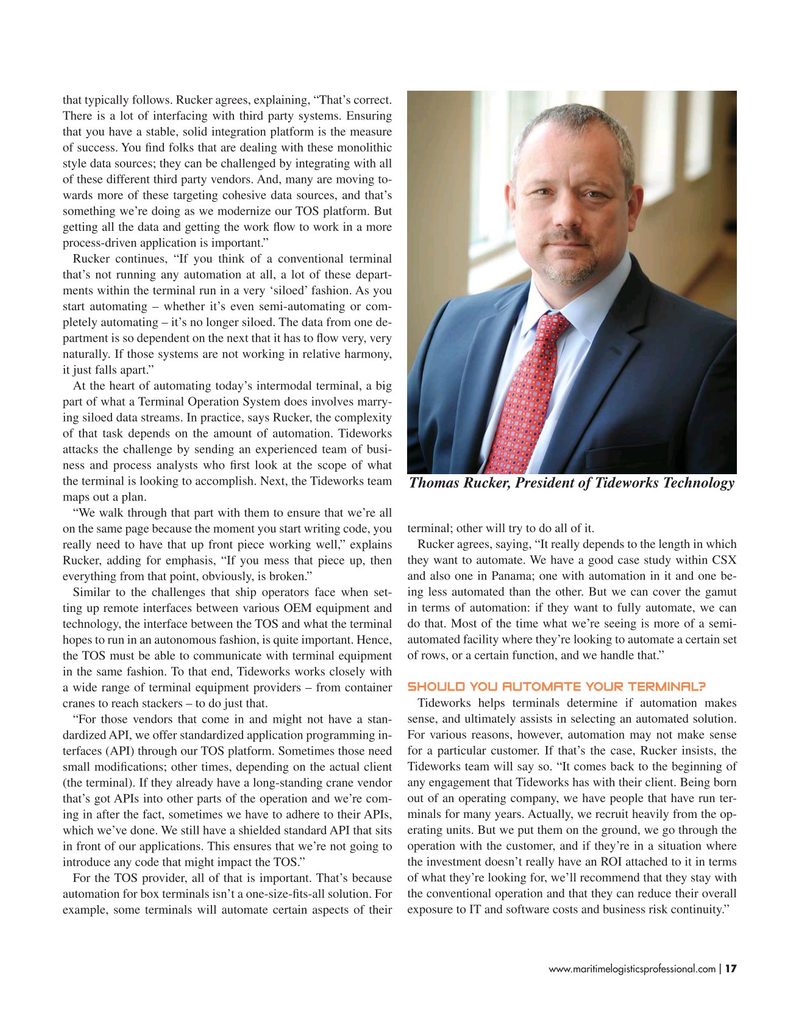
Page 17: of Maritime Logistics Professional Magazine (Mar/Apr 2019)
Container Ports
Read this page in Pdf, Flash or Html5 edition of Mar/Apr 2019 Maritime Logistics Professional Magazine
that typically follows. Rucker agrees, explaining, “That’s correct.
There is a lot of interfacing with third party systems. Ensuring that you have a stable, solid integration platform is the measure of success. You ?nd folks that are dealing with these monolithic style data sources; they can be challenged by integrating with all of these different third party vendors. And, many are moving to- wards more of these targeting cohesive data sources, and that’s something we’re doing as we modernize our TOS platform. But getting all the data and getting the work ?ow to work in a more process-driven application is important.”
Rucker continues, “If you think of a conventional terminal that’s not running any automation at all, a lot of these depart- ments within the terminal run in a very ‘siloed’ fashion. As you start automating – whether it’s even semi-automating or com- pletely automating – it’s no longer siloed. The data from one de- partment is so dependent on the next that it has to ?ow very, very naturally. If those systems are not working in relative harmony, it just falls apart.”
At the heart of automating today’s intermodal terminal, a big part of what a Terminal Operation System does involves marry- ing siloed data streams. In practice, says Rucker, the complexity of that task depends on the amount of automation. Tideworks attacks the challenge by sending an experienced team of busi- ness and process analysts who ?rst look at the scope of what the terminal is looking to accomplish. Next, the Tideworks team
Thomas Rucker, President of Tideworks Technology maps out a plan.
“We walk through that part with them to ensure that we’re all on the same page because the moment you start writing code, you terminal; other will try to do all of it.
really need to have that up front piece working well,” explains Rucker agrees, saying, “It really depends to the length in which
Rucker, adding for emphasis, “If you mess that piece up, then they want to automate. We have a good case study within CSX everything from that point, obviously, is broken.” and also one in Panama; one with automation in it and one be-
Similar to the challenges that ship operators face when set- ing less automated than the other. But we can cover the gamut ting up remote interfaces between various OEM equipment and in terms of automation: if they want to fully automate, we can technology, the interface between the TOS and what the terminal do that. Most of the time what we’re seeing is more of a semi- hopes to run in an autonomous fashion, is quite important. Hence, automated facility where they’re looking to automate a certain set the TOS must be able to communicate with terminal equipment of rows, or a certain function, and we handle that.” in the same fashion. To that end, Tideworks works closely with
SHOULD YOU AUTOMATE YOUR TERMINAL?
a wide range of terminal equipment providers – from container cranes to reach stackers – to do just that. Tideworks helps terminals determine if automation makes “For those vendors that come in and might not have a stan- sense, and ultimately assists in selecting an automated solution. dardized API, we offer standardized application programming in- For various reasons, however, automation may not make sense terfaces (API) through our TOS platform. Sometimes those need for a particular customer. If that’s the case, Rucker insists, the small modi?cations; other times, depending on the actual client Tideworks team will say so. “It comes back to the beginning of (the terminal). If they already have a long-standing crane vendor any engagement that Tideworks has with their client. Being born that’s got APIs into other parts of the operation and we’re com- out of an operating company, we have people that have run ter- ing in after the fact, sometimes we have to adhere to their APIs, minals for many years. Actually, we recruit heavily from the op- which we’ve done. We still have a shielded standard API that sits erating units. But we put them on the ground, we go through the in front of our applications. This ensures that we’re not going to operation with the customer, and if they’re in a situation where introduce any code that might impact the TOS.” the investment doesn’t really have an ROI attached to it in terms
For the TOS provider, all of that is important. That’s because of what they’re looking for, we’ll recommend that they stay with automation for box terminals isn’t a one-size-?ts-all solution. For the conventional operation and that they can reduce their overall example, some terminals will automate certain aspects of their exposure to IT and software costs and business risk continuity.” www.maritimelogisticsprofessional.com 17
I

 16
16

 18
18
